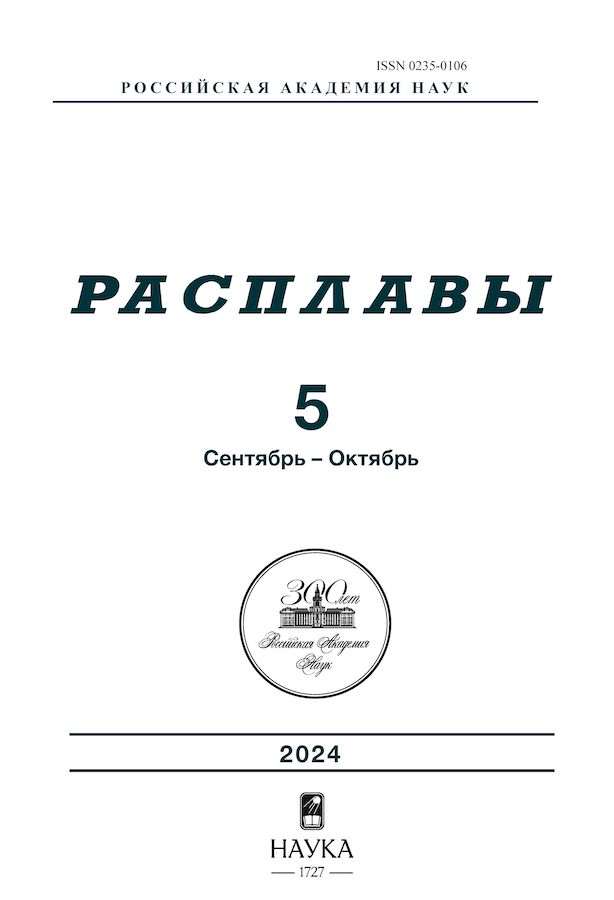The estimation of desulphurization property of boron-containing slags of the reduction period of the AOD process
- Авторлар: Babenko А.А.1, Upolovnikova А.G.1, Kel’ I.N.1, Shartdinov R.R.1
-
Мекемелер:
- Institute of Metallurgy of the Ural Branch of the RAS
- Шығарылым: № 5 (2024)
- Беттер: 491-500
- Бөлім: Articles
- URL: https://rjraap.com/0235-0106/article/view/662034
- DOI: https://doi.org/10.31857/S0235010624050033
- ID: 662034
Дәйексөз келтіру
Аннотация
Now the main industrial method for producing stainless steel is smelting in an argon-oxygen decarburization (AOD) furnace, therefore the paper presents the results of thermodynamic modeling of the desulfurization process of low-carbon semi-finished stainless steel during the reduction period of AOD process by treating it with boron-containing slags. The use of boron oxide as a fluxing material instead of fluorspar reduces the environmental harm and decrease the viscosity of the formed slags. Using the simplex lattice method of experiment planning, a matrix was constructed containing 16 compositions of the oxide system СаО–SiO2–(3-6%)В2О3–12%Cr2O3–3%Al2O3–8%MgO with variable basicity of 1.0–2.5. Based on the generalization of the thermodynamic modeling results, approximating mathematical models in the form of a reduced third-degree polynomial were constructed. The adequacy of the models is verified by three control points not included in the experimental design matrix using the t-criterion at a significance level of 0.01. The results of mathematical modeling are presented graphically in the form of diagrams of the dependence of the equilibrium sulfur distribution on the slag composition at temperatures of 1600 and 1700°C. The constructed diagrams made it possible to quantitatively estimate the effect of temperature, basicity and boron oxide content on the equilibrium interphase distribution coefficient of sulfur. It is found that an increase in slag basicity from 1.0 to 2.5 in the considered range of boron oxide content (3.0–6.0%) improves the metal desulfurization process, ensuring an increase in the equilibrium interphase distribution coefficient of sulfur from 0.1 to 5.0–7.0 at temperatures of 1700 and 1600°C. It’s shown that the process of metal desulfurization in slags with low basicity of 1.05–1.15 is accompanied by a slight decrease in the sulfur content in the metal. At the same time, the concentration of boron oxide has virtually no negative effect on the process of metal desulfurization. Slags with increased basicity up to 2.0–2.5 have more favorable refining properties. The sulfur concentration in the metal during their formation decreases from 0.015 to 0.007–0.008%.
Авторлар туралы
А. Babenko
Institute of Metallurgy of the Ural Branch of the RAS
Хат алмасуға жауапты Автор.
Email: babenko251@gmail.com
Ресей, Yekaterinburg
А. Upolovnikova
Institute of Metallurgy of the Ural Branch of the RAS
Email: babenko251@gmail.com
Ресей, Yekaterinburg
I. Kel’
Institute of Metallurgy of the Ural Branch of the RAS
Email: babenko251@gmail.com
Ресей, Yekaterinburg
R. Shartdinov
Institute of Metallurgy of the Ural Branch of the RAS
Email: babenko251@gmail.com
Ресей, Yekaterinburg
Әдебиет тізімі
- Tyurin A.G., Pyshmincev I.Yu., Kosticyna I.V., et al. Termodinamika himicheskoj i elektrohimicheskoj ustojchivosti korrozionno-aktivnyh nemetallicheskih vklyuchenij [Thermodynamics of chemical and electrochemical stability of corrosion-active non-metallic inclusions] // Zashchita metallov. 2007. 43. № 1. P. 39-49. [In Russian]
- Mach S., Byoni H. Vliyanie temperatury na lokal’nuyu korroziyu nerzhaveyushchej stali [Effect of temperature on localized corrosion of stainless steel] // Elektrohimiya. 2000. 36. № 10. P. 1268-1274. [In Russian]
- Kostina M.V., Krivorotov V.I., Kostina V.S., Kudryashov A.E., Muradyan S.O. Features of chemical composition and structural-phase state decreasing corrosion resistance of parts from 18Cr-10Ni steel // Izvestiya vuzov. Ferrous Metallurgy. 2021. 64. № 3. P. 217-229. [In Russian]
- Tokovoj O.K. Argonokislorodnoe rafinirovanie nerzhaveyushchej stali: monografiya [Argon-oxygen refining of stainless steel: monograph]. Chelyabinsk: Izdatel’skij centr YUUrGU, 2015. [In Russian]
- Cai, J., Li, J. // 12th International Symposium on High-Temperature Metallurgical Processing. Springer, Cham, 2022. P. 71-80. https://doi.org/10.1007/978-3-030-92388-4_7
- Li L., Cheng G., Hu B., Wang C., S., et al. // Metallurgical Research & Technology. 2017. 114. № 1. P. 114. https://doi.org/10.1051/metal/2016044
- Dyudkin D. A., Kisilenko V. V. Proizvodstvo stali. T. 3. Vnepechnaya metallurgiya stali [Steel production. Vol. 3. Secondary metallurgy of steel]. Moskva: Teplotekhnik, 2010. [In Russian]
- Jeong T. S., Сho J. H.. Heo J.H., Park J.H. // Journal of Materials Research and Technology. 2022. 18. P. 2250-2260. ttps://doi.org/10.1016/j.jmrt.2022.03.048
- Duan S., Kim T., Cho J., et al. Evolution Behavior of Non-Metallic Inclusions in Si-Killed 316l Stainless Steel with Various Refining Slags // Available at SSRN 4653855. http://dx.doi.org/10.2139/ssrn.4653855
- Sheshukov O. Yu., Vdovin K.N., Shevchenko O.I., Racional’noe navedenie shlaka pri vyplavke stali 110G13L [Rational slag guidance during smelting of 110G13L steel] // Stal’. 2017. № 2. P. 20-22. [In Russian]
- Park J.H., Suk M.O., Jung I.H. et al. // Steel research international. 2010. 81. № 10. P. 860-868. https://doi.org/10.1002/srin.201000157
- Han J. S. Kang J.G., Shin J.H. et al. // Ceramics International. 2018. 44. № 11. P. 13197-13204. https://doi.org/10.1016/j.ceramint.2018.04.145
- Nemenyonok B.M., Tribushevskij L.V., Rumyanceva G.A et al. Snizhenie vrednyh gazovyh vybrosov pri vnepechnoj obrabotke stali [Reduction of harmful gas emissions during secondary steel processing] // Metallurgiya: respublikanskij mezhvedomstvennyj sbornik nauchnyh trudov. 2023. № 43. P. 7-15. [In Russian]
- Zhuchkov V.I., Leont’ev L.I. Akberdin A.A. et al. Primenenie bora i ego soedinenij v metallurgii [application of boron and its compounds in metallurgy]. Novosibirsk; Yekaterinburg: Akademizdat, 2018. [In Russian]
- Zheng L., Li H., Wang X., Jiang Z. et al. // ISIJ International. 2021. 61. № 6. P. 1784-1793. https://doi.org/10.2355/isijinternational.ISIJINT-2020-744
- Morii, L., Kumura Sh., Mori H. et al. // DENKI-SEIKO. 1993. 64. № 1. P.4-12. https://doi.org/10.4262/denkiseiko.64.4
- Hongming, W., Tingwang, Z., Hua, Z. // ISIJ International. 2011. 51. № 5. P. 702-708. http://dx.doi.org/10.2355/isijinternational.51.702
- Qiu G., Zhang H., GaO P. et al. // Steel research international. 2024. 95. № 1. P. 2300333. https://doi.org/10.1002/srin.202300333
- Wang H., Zhang T., Zhu H. et al. // ISIJ International. 2011. 51. № 5. P. 702–706. https://doi.org/10.2355/isijinternational.51.702
- Wang H. M., Fu D., Li G.R. et al. // Applied Mechanics and Materials. 2012. 217. P. 511-514. https://doi.org/10.4028/www.scientific.net/AMM.217-219.511
Қосымша файлдар









